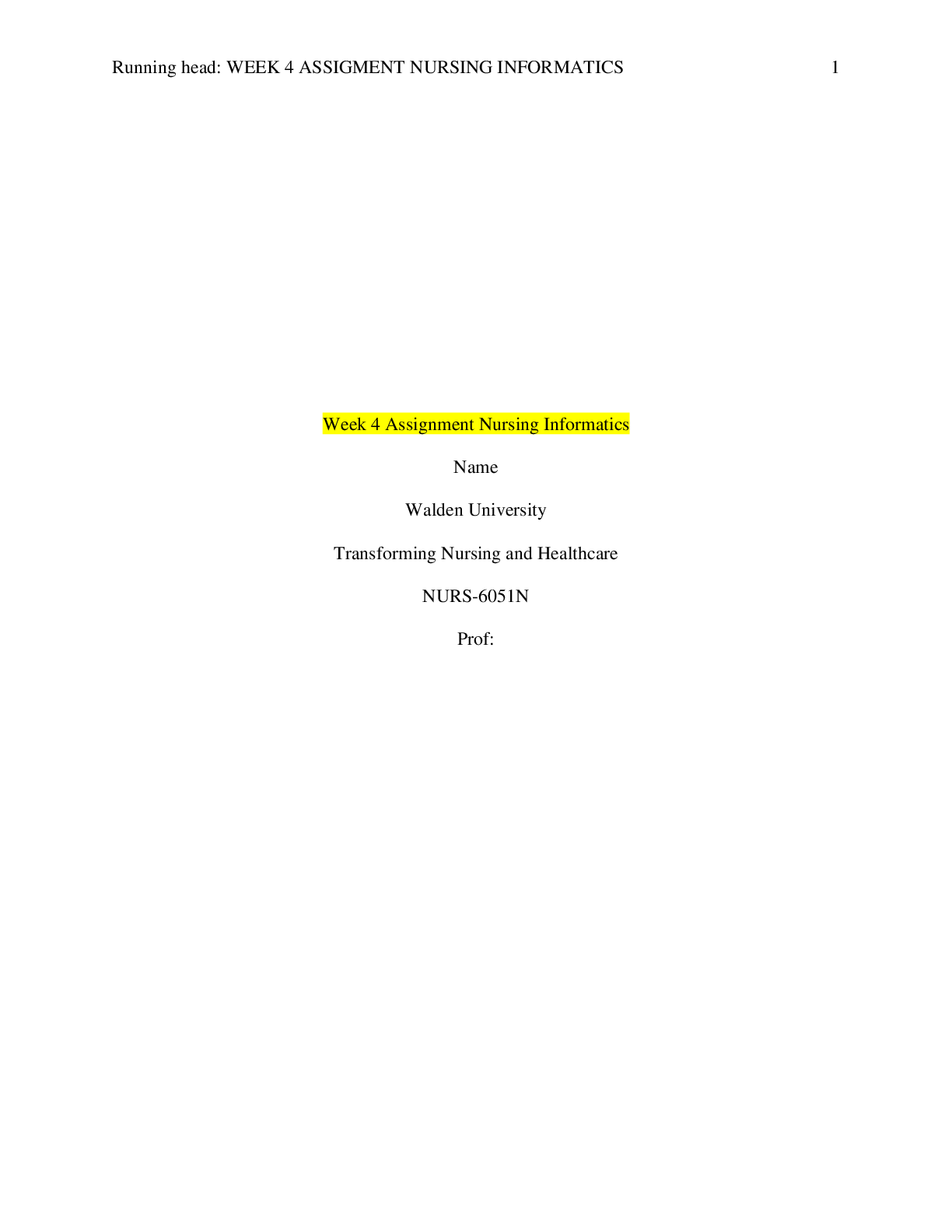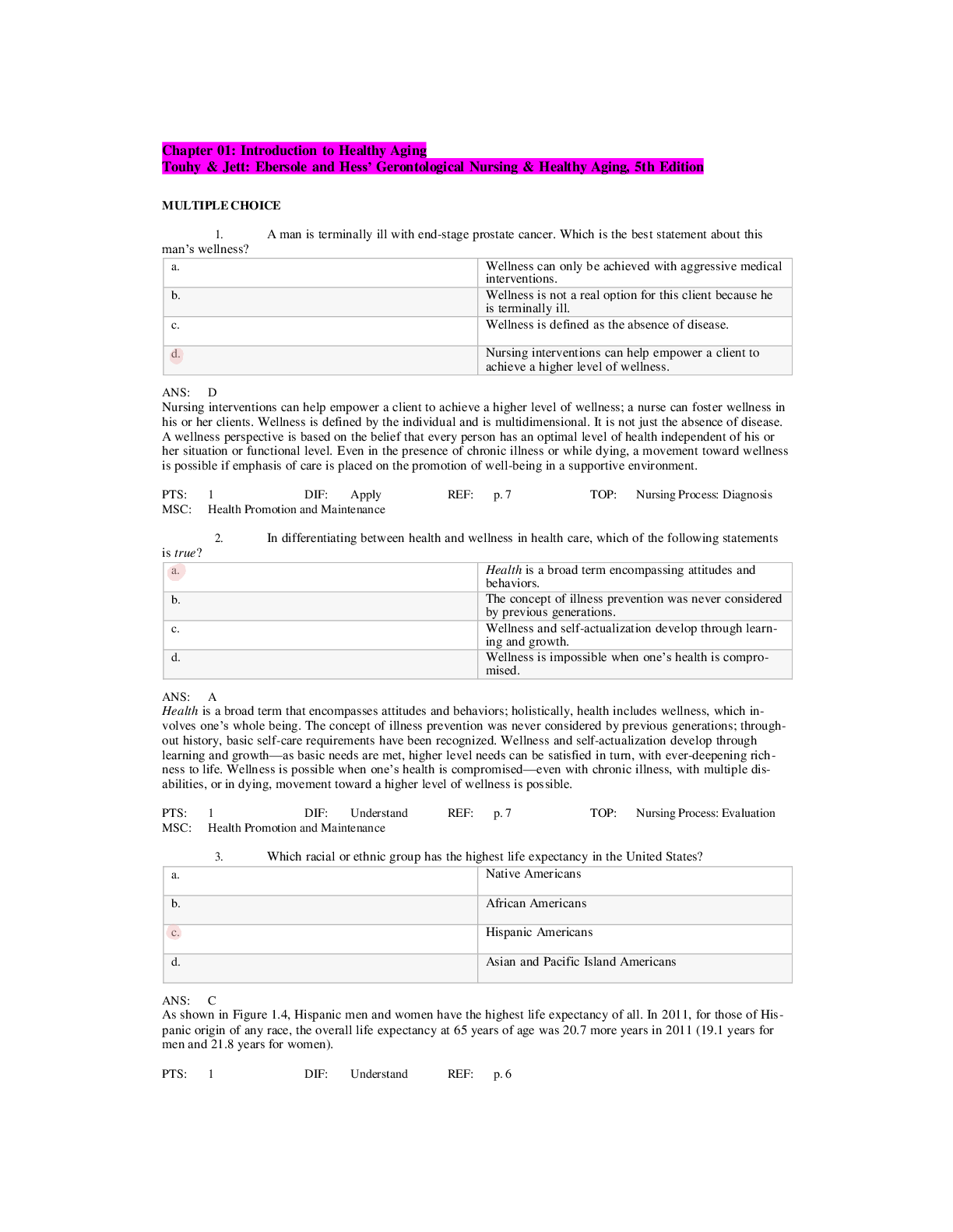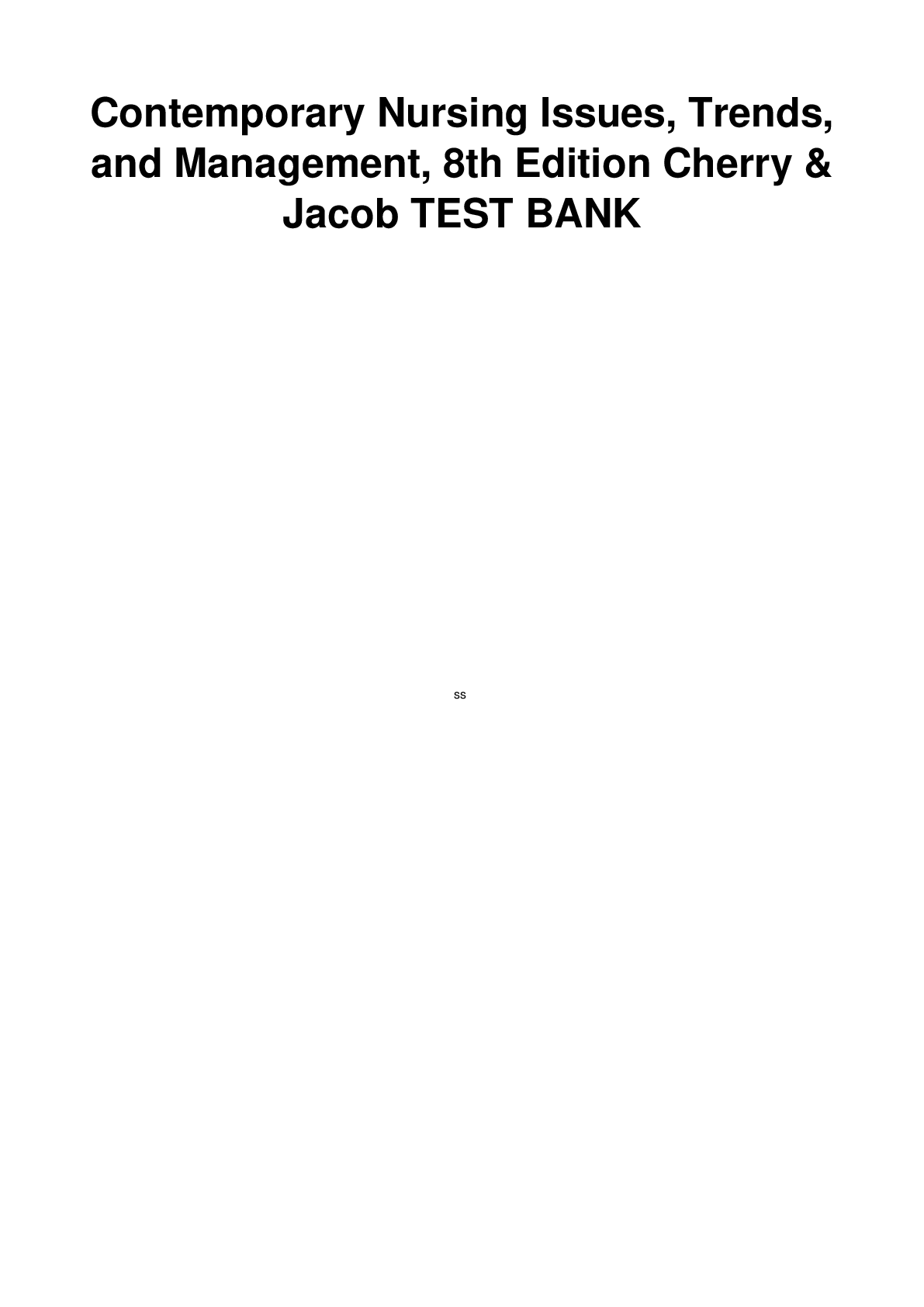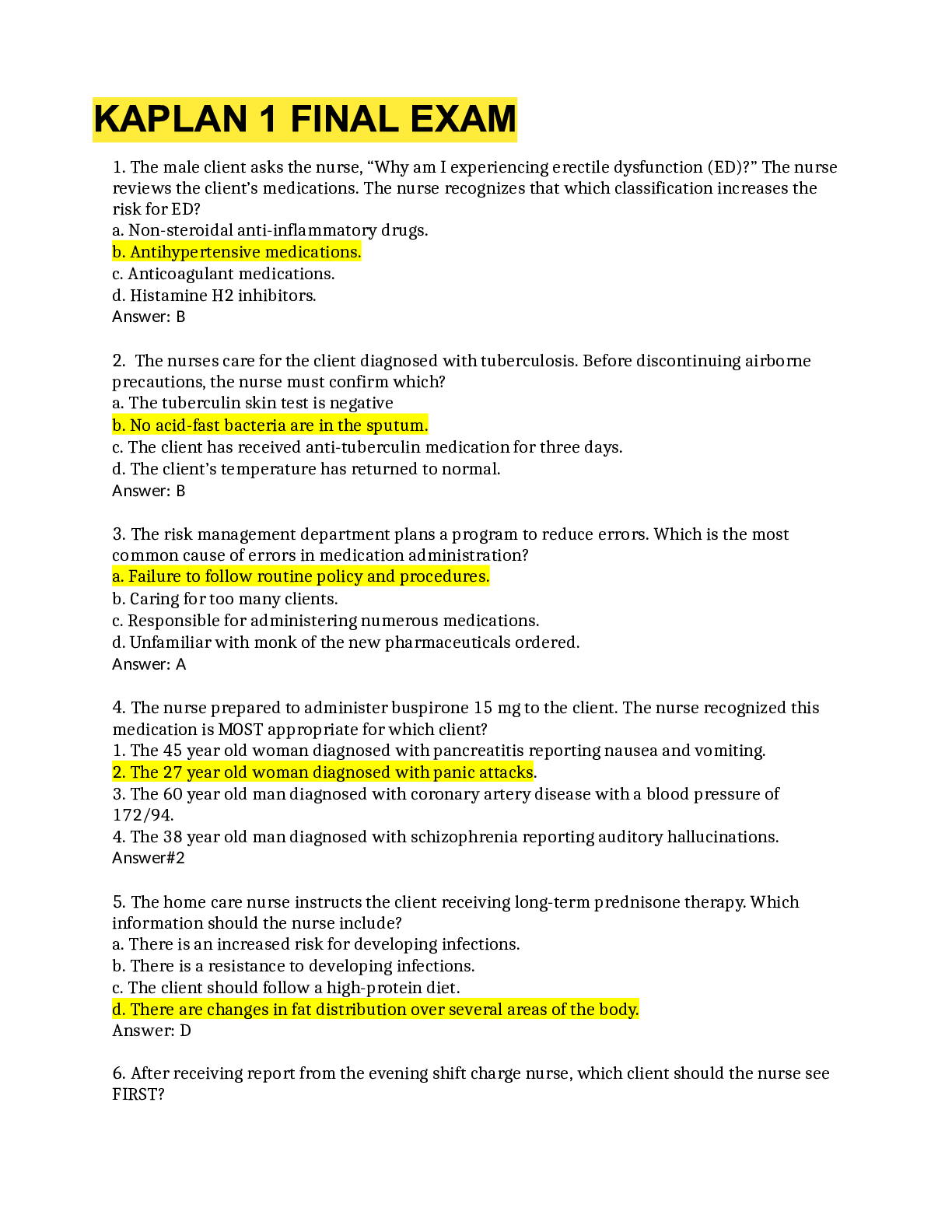*NURSING > EXAM > Chapter 08: Legal Issues in Nursing and Health Care Cherry & Jacob: Contemporary Nursing: Issues, Tr (All)
Chapter 08: Legal Issues in Nursing and Health Care Cherry & Jacob: Contemporary Nursing: Issues, Trends, and Management, 7th Edition
Document Content and Description Below
Chapter 08: Legal Issues in Nursing and Health Care Cherry & Jacob: Contemporary Nursing: Issues, Trends, and Management, 7th Edition MULTIPLE CHOICE 1. A client arrives in active labor and exhi... bits toxemia with irregular fetal heart tones. The client is an immigrant and is uninsured. Which act would prevent the client from being transferred to another facility? a. Emergency Medical Treatment and Active Labor Law b. Health Insurance Portability and Accountability Act c. Patient Self-Determination Act d. The Patient Safety and Quality Improvement Act ANS: A The Emergency Medical Treatment and Active Labor Law is a federal statute that was enacted in 1986 to prohibit the transfer of unstable clients, including women in labor, from one facility to another. This law also prohibits refusal of care for indigent and uninsured clients who seek medical assistance in the emergency department. DIF: Comprehension REF: p. 123 2. A nurse is caring for a client with malignant hypertension whose blood pressure has increased by 40 mm Hg during the past hour. The nurse goes to lunch and fails to report the change to the physician. The nurse is at risk for being charged with: a. negligence. b. assault. c. defamation of character. d. tort. ANS: A Negligence is defined as failure to act in a reasonable and prudent manner. The most frequent allegations of nursing negligence include failure to ensure client safety, improper treatment, failure to monitor the client and report significant findings, medication errors, and failure to follow the agency’s policies and procedures. DIF: Comprehension REF: p. 120|p. 132 3. A nurse is caring for a client who just suffered a stroke and is medicated for pain. The nurse completes the following interventions: places the client on the examining table, completes a thorough history and physical, covers the client with a sheet, places the call button within reach, and goes out in the hall to speak with the client’s physician. The client tries to get up to speak with his family and falls, sustaining a hematoma on the head and a broken hip. The nurse’s actions reflect: a. invasion of privacy. b. libel. c. slander. d. negligence. ANS: D The nurse is failing to ensure client safety after medication administration; this is defined as negligence. DIF: Comprehension REF: p. 120|p. 132 4. A nursing student planning to apply for licensure knows that being charged with which offense would result in a minor criminal offense? a. Solicitation of illegal drugs b. Stealing a car c. Failing to report elder abuse d. Billing Medicare for services not rendered ANS: C Failing to report elder abuse can lead to penalty of fine or imprisonment. DIF: Comprehension REF: p. 150 5. When differentiating between slander and libel, the nurse knows that libel: a. results from defamation caused by subjective comments written in the nurse’s notes. b. results from negative subjective comments made to those who are not providing care. c. occurs when the nurse verbally describes to the oncoming nurse assigned to the client objective data that place the client in a negative light. d. consists of repeating prejudiced comments made by the primary caregiver to a neighbor at the local supermarket. ANS: A Libel is defined as comments that are written about a person that are defaming. Nurses may be subject to a charge of libel for subjective comments meant to denigrate the client that are placed in the medical record or in other written materials read by others. DIF: Comprehension REF: p. 149 6. Which statement regarding informed consent is correct? Informed consent: a. is mandated by federal but not state law. b. must reveal expected benefits. c. requires concealing any known risks. d. allows the RN to communicate information needed so that informed consent can be provided. ANS: B The information that constitutes informed consent for the client includes the nature of the therapy or procedure, expected benefits and outcomes of the therapy or procedure, potential risks of the therapy or procedure, alternative therapies to the intended procedure and their risks and benefits, and risks of not having the procedure. DIF: Comprehension REF: p. 152 7. A client states, “I am leaving. No one here knows what they are doing.” The nurse completing the Against Medical Advice form must: a. defer notifying the provider until the client has had ample time to leave. b. state in medical terms the risks of leaving. c. inform the client that leaving could result in complications and impairment. d. detain the person with the use of soft restraints until security arrives. ANS: C The nurse must articulate to the client the dangers associated with leaving the facility if the primary provider is not present. The nurse’s notes on this form should reflect the specific advice given to the client, which should include the fact that leaving the facility could aggravate the current condition and complicate future care, result in permanent physical or mental impairment or disability, or result in complications that can cause death. DIF: Application REF: p. 93 8. When can a nurse detain a client by using restraints? a. Staffing resources are insufficient to monitor a patient with hemiplegia. b. The client is confused. c. The family requests the restraints to prevent the client from leaving the facility. d. There are current physician orders following a medical evaluation. ANS: D A written physician’s order that is timed and dated is required for the use of restraints. Renewal of orders must be accompanied by evidence of medical evaluation and nursing reassessment. DIF: Comprehension REF: p. 155 9. When the client is unable to make medical decisions for himself or herself, authorization that allows another person to make these decisions is called: a. living will. b. durable power of attorney. c. informed consent. d. immunity. ANS: B Durable power of attorney involves preselection by the client of a person who has been authorized legally to make health care decisions once the client becomes incompetent to do so. Several states have enacted a Uniform Durable Power of Attorney Act, which sanctions a durable power of attorney for health care. DIF: Knowledge REF: p. 152 10. All hospitals receiving Medicare and Medicaid funds must ask clients whether they have a living will or a durable power of attorney. This act is known as the: a. Emergency Treatment and Active Labor Law. b. Americans with Disabilities Act. c. Uniform Health Care Decisions Act. d. doctrine of res ipsa loquitur. ANS: C The Uniform Health Care Decisions Act of 1993 is a federal statute that was established to support individuals in expressing their preferences about medical treatment and making decisions about end-of-life care. DIF: Comprehension REF: p. 152 11. A nurse who functions in the role of team leader can be held negligent for matters involving: a. inadequate training. b. lack of development of proper policies and procedures. c. failure to discipline unsafe workers. d. delegation of client care tasks. ANS: D Delegation of client care tasks falls within the role of the team leader, and inappropriate delegation of client care tasks could result in negligence. Team leaders, charge nurses, and managers are held to the standard of care of the reasonably prudent nurse employed in that role. DIF: Comprehension REF: p. 144 12. Although a hospital reversed all charges when a client was the victim of wrong site surgery, the court awarded the client $1.5 million. The client was able to return to work in 6 weeks and had no permanent damages. This monetary compensation is termed: a. res ipsa loquitur. b. punitive damages. c. vicarious liability. d. immunity. ANS: B Punitive damages are monetary compensation to an injured client that is greater than amount of loss. DIF: Application REF: p. 120 |p. 135 13. A physician orders a drug for a patient with a known allergy resulting in anaphylactic shock. The nurse: a. realizes that disclosure of the error will result in more severe ramifications for the agency than if the negligence is discovered by the patient or family. b. should disclose the occurrence before speaking with the physician who ordered the drug or with hospital management. c. recognizes disclosure as an essential component of the national patient safety movement. d. should report the occurrence to the patient’s insurance company to decrease patient costs. ANS: C The National Quality Forum identified the process of disclosure as a key element of the national patient safety movement. DIF: Application REF: p. 139 14. A nurse is charged with battery after helping an invalid patient back to bed and not calling for help due to a reduced staffing level. The patient sustained excessive bruising, sore joints, and extended stay. In this case, the: a. patient is the plaintiff. b. nurse can be charged with forcefully restraining the patient without orders. c. nurse is accountable due to the decreased level of staffing. d. charge of invasion of privacy may be withheld. ANS: A The complaining person in a lawsuit is the plaintiff. DIF: Application REF: p. 120 15. A nurse working in a privately owned hospital is charged with a negligent act after failing to check laboratory reports prior to giving a dose of digoxin (Lanoxin) resulting in the patient’s condition becoming critical due to decreased cardiac output and falling leading to a broken hip and concussion. A nurse is brought in who testifies that a professional with the knowledge and skill of an RN should understand that, before administering this drug, potassium level and pulse level is always checked to prevent such an occurrence. The nurse’s testimony as to what constitutes reasonable care is based on: a. the legal definition of standard of care. b. the legal definition of the informed consent process. c. the doctrine of res ipsa loquitur. d. governmental immunity. ANS: A Standard of care is the legal criteria against which the nurse’s (and physician’s) conduct is compared to determine whether a negligent act or malpractice occurred. Nurses are specialists in hospital care who, in the final analysis, hold the well-being—in some instances, the very lives—of patients in their hands. DIF: Comprehension REF: p. 120 16. On a nursing unit all assigned breaks including lunch/dinner breaks are assigned at the beginning of the shift. A nurse caring for a patient with anemia and heart failure prepares to hang a unit of packed red blood cells and realizes her break is in 5 minutes. She decides it is not necessary to have another nurse check the blood against the patient’s information since the patient’s blood type is O+ which she incorrectly remembered to be the universal donor. She hangs the blood, noting the patient is “reading and vital signs normal.” She leaves the floor for her break and does not report leaving or ask anyone to perform required vital signs. Upon returning she meets a family friend who is visiting and time “just flies.” She returns to the patient’s room after admitting a new patient. The patient is hypotensive and color is cyanotic and anxious. She reports the findings to the charge nurse, who then contacts the physician. A blood reaction occurrence is noted. The nurse providing care is charged: a. with comparative negligence. b. with a preventable adverse event. c. with criminal negligence. d. under the doctrine of res ipsa loquitur. ANS: C In this case, criminal negligence charges would be based on “reckless and wanton” disregard for the safety, well-being, or life of an individual; behavior that demonstrates a complete disregard for another, such that death is likely in the transfusion reaction. Type “O” is the universal donor rather than universal recipient; however, regardless of blood type, policy and procedures for assessing vital signs and patient status during blood transfusion must be followed. DIF: Comprehension REF: p. 120|p. 136 17. A physician shares with the patient’s family that, while a central line was being inserted, the patient’s lungs were inadvertently punctured, which required oxygen administration. The physician also explains that a chest x-ray indicated the lung remained intact and no additional treatment was required. The physician’s role in this instance is based on the legal principle of: a. comparative negligence. b. gross negligence. c. disclosure. d. the Emergency Medical Treatment and Active Labor Act (EMTALA). ANS: C Disclosure is a process in which the patient’s primary provider (physician or advanced practice nurse) gives the patient, and when applicable, family members, complete information about unanticipated adverse outcomes of treatment and care. DIF: Comprehension REF: p. 120| p. 139 18. A nurse is assigned to a unit other than the one she is normally assigned due to increased census on the alternate unit. She is assigned to care for seven patients and participates in walking rounds where the patient’s condition and needs are discussed between oncoming and off-going shifts of the interdisciplinary team. The nurse carefully makes notes of all pending orders and prioritizes needs. The nurse enters the cafeteria later and the notes accidentally fall from her pocket, which contain the above information that contains patient sensitive data. The liabilities arising from this incident would be covered under: a. the Health Insurance Portability and Accountability Act. b. the ANA Scope and Practice Act. c. affirmative duty failing to question order. d. personal liability with floating and cross-training. ANS: A HIPAA protects patient information and ensures confidentiality of data. DIF: Analysis REF: p. 125 MULTIPLE RESPONSE 1. Which types of abuse are the nurse required to report or be subject to fines and imprisonment for not reporting? (select all that apply) a. Animal b. Child c. Alcohol d. Infant e. Emotional ANS: B, D State laws have been created as a result of the 1973 Child Abuse Prevention and Treatment Act. These laws dictate that health professionals must report infant and child abuse and specified communicable diseases. Failure by the nurse to comply can result in fines and/or imprisonment. DIF: Comprehension REF: p. 130 2. A patient asks, “What is an advance directive?” The nurse explains that examples of advance directives are: (select all that apply) a. preserving cord blood for possible future needs of a child. b. providing instructions that life- sustaining medical procedures should be withheld in the event of a terminal situation. c. giving someone the legal right to act on one’s behalf when one becomes incapacitated. d. completing hospital admission paperwork before being admitted to the hospital. ANS: B, C Advance directives document an individual’s desires regarding end-of- life care. These wishes are generally stated through the execution of a formal document known as the living will. Right-to-die statutes vary from state to state; therefore, nurses must become familiar with their state-specific statute. DIF: Analysis REF: p. 120|p. 151 3. A nurse learns in orientation that an incident report does not “blame” anyone but concisely documents the events leading up to an occurrence. Which events would warrant completion of an incident report? (select all that apply) a. The client is crying and distraught when he learns of a diagnosis of cancer. b. An intravenous antibiotic given preoperatively does not infuse because of a faulty pump. c. The nurse is unable to carry out orders written by the specialist because of illegibility. d. A client falls while in the shower, although she was told not to get up alone. e. The registered nurse is not available to complete the preoperative checklist. ANS: B, C, D, E Nurses are legally bound to report critical incidents to their nurse managers, agency administration, and risk manager through a formal intra-agency document generally titled the “incident report.” Circumstances under which an incident report should be filed include malfunction or failure of medical equipment. DIF: Analysis REF: p. 146 [Show More]
Last updated: 1 year ago
Preview 1 out of 10 pages
 (1).png)
Buy this document to get the full access instantly
Instant Download Access after purchase
Add to cartInstant download
We Accept:

Reviews( 0 )
$10.00
Document information
Connected school, study & course
About the document
Uploaded On
May 10, 2021
Number of pages
10
Written in
Additional information
This document has been written for:
Uploaded
May 10, 2021
Downloads
0
Views
33






.png)













 4th Edition Test Bank By Smith PhD RN AHN-BC FAAN, Marlaine, Parker PhD RN FAAN, Marilyn E (1) (1).png)

.png)


